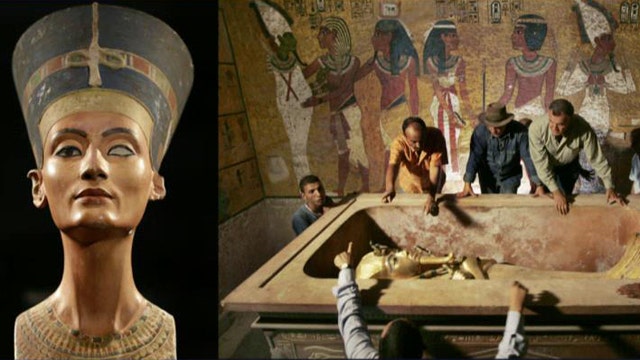Could Egyptian queen Nefertiti be hidden in King Tut's tomb?
English archaeologist suggests boy pharaoh's mother may be lying behind secret door
An English archaeologist has suggested that the tomb of Tutankhamun, the most famous of Egypt's pharaohs, is hiding a secret that has eluded researchers since its discovery more than 90 years ago.
Dr. Nicholas Reeves of the University of Arizona told the Times of London that he believes he has discovered a secret doorway leading from the tomb of King Tut to that of, Nefertiti, believed to be the boy-king's mother and one of the most powerful women of the ancient world.
Reeves told the Times that he discovered the bricked-up "ghosts" of the doorways after examining digital scans of the walls of Tutankhamun's tomb in the Valley of the Kings, across the Nile River from Luxor in southern Egypt. He believes that one of the doorways leads to a little-used storeroom, but the other, on the north side of the tomb, leads to "the undisturbed burial of the tomb's rightful owner."
If Reeves is correct, the room containing Tut's tomb -- discovered by English archaeologist Howard Carter to global acclaim in 1922 -- was built to be an antechamber to that of the more illustrious and glamorous Nefertiti. It would also explain some facts about Tutankhamun's resting place that have puzzled researchers.
For one thing, the size of Tutankhamun's tomb is smaller than those of other Egyptian kings. Second, as Reeves writes, many of the artifacts that have enraptured millions of museum visitors around the world are largely second-hand, having been recycled from earlier burials.
Finally, the opening in question appears to have been decorated with religious scenes at an earlier date than the other three walls of Tutankhamen's tomb. The scenes would have been meant to confer protection on the room beyond.
"Only one female royal of the late 18th Dynasty is known to have received such honours [sic], and that is Nefertiti," Reeves wrote in a report published by the Armana Royal Tombs Project.
Nefertiti, who bore the titles "Lady of All Women" and "Mistress of Upper and Lower Egpyt" during her lifetime, ruled as the chief consort of the pharaoh Akhenaten in the late 14th century B.C.. She is believed to have died in around 1330 B.C., approximately seven years before the estimated date of Tutankhamun's death.
Despite her fame and power during her lifetime, no one is quite sure where she has been buried. Some believe she was buried at Armana, the capital city established by her husband approximately 250 miles north of the Valley of The Kings. Others say one of two mummies discovered in the Valley of the Kings may be the former Queen of Egypt.

